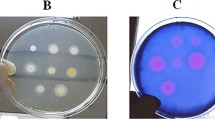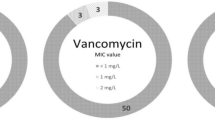Abstract
Vancomycin resistance in methicillin-resistant staphylococci presents a potential therapeutic problem. In order to understand the impact of low-level vancomycin resistance in coagulase-negative Staphylococci, stepwise selection of vancomycin resistance was accomplished by growingstaphylococcus haemolyticus in culture media with increasing concentrations of vancomycin. A >40-fold increase in susceptibility to β-lactam antibiotics was observed. No obvious alterations in the growth curve, the presence of themecA gene, total DNA restriction fragment length polymorphism (RFLP), β-lactamase production, or the crude protein fraction were detected in thestaphylococcus haemolyticus-derived clones when compared to the original isolate. The proportion of the oxacillin-heteroresistant population also remained similar. A comparable phenomenon occurred with the selection ofstaphylococcus epidermidis exhibiting low-level resistance to vancomycin. Additionally, it was observed that clinical isolates of coagulase-negative Staphylococci grown in the presence of sub-minimum inhibitory concentrations of either vancomycin or teicoplanin lost their high-level resistance to oxacillin. Checkerboard tests showed that the combination of vancomycin and oxacillin was synergistic for two isolates ofStaphylococcus haemolyticus, two of four isolates ofStaphylococcus epidermidis, and one isolate ofStaphylococcus hominis.
Similar content being viewed by others
References
Edmond MB, Wenzel RP, Pasculle AW: Vancomycin-resistantStaphylococcus aureus: perspectives on measures needed for control. Annals of Internal Medicine (1996) 124:329–334.
Georgopapadakou NH: Penicillin-binding proteins and bacterial resistance to β-lactams. Antimicrobial Agents and Chemotherapy (1993) 37:2045–2053.
Johnson AP, Uttley AHC, Woodford N, George RC: Resistance to vancomycin and teicoplanin: an emerging clinical problem. Clinical Microbiology Reviews (1990) 3:280–291.
Aubert G, Passot S, Lucht F, Dorche G: Selection of vancomycin- and teicoplanin-resistantStaphylococcus haemolyticus during teicoplanin treatment ofStaphylococcus epidermidis infection. Journal of Antimicrobial Chemotherapy (1990) 25:491–493.
Schwalbe RS, Stapelton JT, Gilligan HP: Emergence of vancomycin resistance in coagulase-negative staphylococci. New England Journal of Medicine (1987) 316:2432–2437.
Veach LA, Pfaller MA, Barrett M, Koontz FP, Wenzel RP: Vancomycin resistance inStaphylococcus haemolyticus causing colonization and bloodstream infection. Journal of Clinical Microbiology (1990) 28:2064–2068.
Herwaldt L, Boyken L, Pfaller M: In vitro selection of resistance to vancomycin in bloodstream isolates ofStaphylococcus haemolyticus andStaphylococcus epidermidis. European Journal of Clinical Microbiology & Infectious Diseases (1991) 10:1007–1012.
Biavasco F, Giovanetti E, Montanari MP, Lupidi R, Varaldo PE: Development of in-vitro resistance to glycopeptide antibiotics: assessment in staphylococci of different species. Journal of Antimicrobial Chemotherapy (1991) 27:71–79.
Schwalbe RS, Ritz WJ, Verma PR, Barranco EA, Gilligan PH: Selection for vancomycin resistance in clinical isolates ofStaphylococcus haemolyticus. Journal of Infectious Diseases (1990) 161:45–51.
Jett BD, Huycke MM, Gilmore MS: Virulence of enterococci. Clinical Microbiology Reviews (1994) 7:462–478.
Murray B: New aspects of antimicrobial resistance and the resulting therapeutic dilemmas. Journal of Infectious Diseases (1991) 163:1185–1194.
Van Horn KG, Gedris CA, Rodney KM: Selective isolation of vancomycin-resistant enterococci. Journal of Clinical Microbiology (1996) 34:924–927.
Roychoudhury S, Dotzlaf JE, Ghag S, Yeh WK: Purification, properties, and kinetics of enzymatic acylation with β-lactams of soluable penicillin-binding protein 2a. Journal of Biolological Chemistry (1994) 269:12067–12073.
De Lencastre H, De Lencastre A, Tomasz A: Methicillin-resistantStaphylococcus aureus isolates recovered from a New York City hospital: analysis by molecular fingerprinting techniques. Journal of Clinical Microbiology (1996) 34:2121–2124.
Reynolds PE: Structure, biochemistry and mechanism of action of glycopeptide antibiotics. European Journal of Clinical Microbiology & Infectious Diseases (1989) 8:943–950.
Walsh CT: Vancomycin resistance: decoding the molecular logic. Science (1993) 261:308–309.
Arthur M, Molinas C, Bugg TDH, Wright GD, Walsh CT: Evidence for in vivo incorporation of D-lactate into peptidoglycan precursors of vancomycin-resistant enterococci. Antimicrobial Agents and Chemotherapy (1992) 36:867–869.
Fraimow HS, Shlaes DM: Glycopeptide resistance in gram-positive pathogens. In: Jungkind DL, Mortenson JE, Fraimow HS, Calandra GB (eds): Antimicrobial resistance: a crisis in health care. Plenum Press, New York, (1995) pp 81–95.
Sieradzki K, Tomasz A: Inhibition of cell wall turnover and autolysis by vancomycin in a highly vancomycin-resistant mutant ofStaphylococcus aureus. Journal of Bacteriology (1997) 179:2557–2566.
Sieradzki K, Tomasz A: A highly vancomycin-resistant laboratory mutant ofStaphylococcus aureus. FEMS Microbiology Letters (1996) 142:2557–2566.
National Committee for Clinical Laboratory Standards: Methods for dilution antimicrobial susceptibility tests for bacteria that grow aerobically. Approved standard, M7-A4. NCCLS, Villanova, Pa., (1996).
Kacica M, Horgan MJ, Preston KE, Lepow M, Venezia RA: Relatedness of coagulase-negative staphylococci causing bacteremia in low-birthweight infants. Infection Control and Hospital Epidemiology (1994) 15:658–662.
Tomasz A, Nachman S, Leaf H: Stable classes of phenotypic expression on methicillin-resistant clinical isolates of staphylococci. Antimicrobial Agents and Chemotherapy (1991) 35:124–129.
Froggat JW, Johnston JL, Galetto DW, Archer GL: Antimicrobial resistance in nosocomial isolates ofStaphylococcus haemolyticus. Antimicrobial Agents and Chemotherapy (1989) 33:460–466.
Jones R, Sader HS: The clinical impact of enterococcal resistance. Challenges in Infectious Disease (1993) 1:1–6.
Daum RS, Gupta S, Sabbagh R, Milewski WM: Characterization ofStaphylococcus aureus isolates with decreased susceptibility to vancomycin and teicoplanin: isolation and purification of a constitutively produced protein associated with decreased susceptibility. Journal of Infectious Diseases (1992) 166:1066–1072.
Handwerger S, Pucci MJ, Volk KJ, Liu J, Lee MS: The cytoplasmic peptiodoglycan precursor of vancomycin-resistantEnterococcus faecalis terminates in lactate. Journal of Bacteriology (1992) 174:5982–5984.
Woodford N, Johnson AP, Morrison D, Speller DCE: Current perspectives on glycopeptide resistance. Clinical Microbiology Reviews (1995) 8:585–615.
Hiramatsu K, Hanaki H, Ino T, Yabuta K, Oguri T, Tenover FC: Methicillin-resistantStaphylococcus aureus clinical strain with reduced vancomycin susceptibility. Journal of Antimicrobial Chemotherapy (1997) 40:135–146.
Shlaes DM, Shlaes JH: Teicoplanin selects forStaphylococcus aureus that is resistant to vancomycin. Clinical Infectious Diseases (1995) 20:1071–1073.
Leclercq R, Bingen E, Su QH, Lambert-Zechovski N, Courvalin P, Duval J: Effects of combinations of β-lactams, daptomycin, gentamicin, and glycopeptides against glycopeptide-resistant enterococci. Antimicrobial Agents and Chemotherapy (1991) 35:92–98.
Sieradzki K, Villari P, Tomasz A: Decreased susceptibilities to teicoplanin and vancomycin among coagulase-negative methicillin-resistant clinical isolates of staphylococci. Antimicrobial Agents and Chemotherapy (1998) 42:100–107.
Author information
Authors and Affiliations
Rights and permissions
About this article
Cite this article
Domaracki, B.E., Evans, A., Preston, K.E. et al. Increased oxacillin activity associated with glycopeptides in coagulase-negative staphylococci. Eur. J. Clin. Microbiol. Infect. Dis. 17, 143–150 (1998). https://doi.org/10.1007/BF01691109
Issue Date:
DOI: https://doi.org/10.1007/BF01691109




